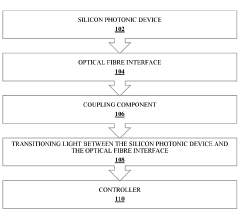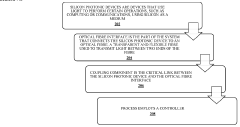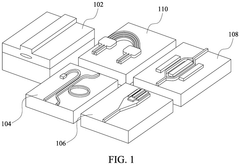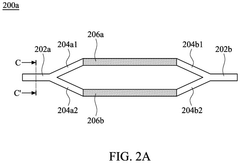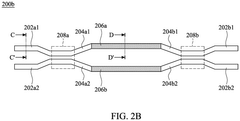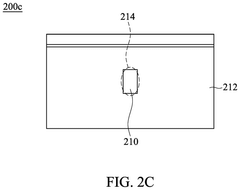Role of silicon photonics in computational biology breakthroughs.
JUL 17, 20259 MIN READ
Generate Your Research Report Instantly with AI Agent
Patsnap Eureka helps you evaluate technical feasibility & market potential.
Silicon Photonics in Computational Biology: Overview and Objectives
Silicon photonics has emerged as a transformative technology in the field of computational biology, offering unprecedented capabilities for data processing and analysis. This convergence of photonics and biology represents a significant leap forward in our ability to tackle complex biological problems at scale. The primary objective of integrating silicon photonics into computational biology is to overcome the limitations of traditional electronic systems in terms of speed, power consumption, and data throughput.
The evolution of silicon photonics in computational biology can be traced back to the early 2000s when researchers began exploring the potential of optical computing for biological data analysis. Since then, the field has witnessed rapid advancements, driven by the increasing demand for high-performance computing solutions in genomics, proteomics, and systems biology. The current technological landscape is characterized by a growing synergy between photonic integrated circuits and biological data processing algorithms.
One of the key trends shaping this field is the development of on-chip optical biosensors that can perform real-time analysis of biological samples. These sensors leverage the unique properties of silicon photonics, such as high sensitivity and multiplexing capabilities, to enable rapid and accurate detection of biomolecules. Another significant trend is the integration of photonic neural networks into computational biology workflows, allowing for more efficient processing of large-scale biological datasets.
The primary technical goals in this domain include enhancing the speed and efficiency of DNA sequencing, improving the accuracy of protein structure prediction, and accelerating drug discovery processes. Silicon photonics is expected to play a crucial role in achieving these objectives by enabling faster data transfer rates, reducing energy consumption, and facilitating parallel processing of biological information.
As we look towards the future, the potential applications of silicon photonics in computational biology are vast and promising. From personalized medicine to environmental monitoring, the integration of these technologies is poised to revolutionize our understanding of complex biological systems and drive innovations in healthcare and biotechnology. The ongoing research and development efforts in this field are focused on overcoming current technical challenges, such as improving the integration density of photonic components and enhancing the compatibility between photonic and electronic systems.
The evolution of silicon photonics in computational biology can be traced back to the early 2000s when researchers began exploring the potential of optical computing for biological data analysis. Since then, the field has witnessed rapid advancements, driven by the increasing demand for high-performance computing solutions in genomics, proteomics, and systems biology. The current technological landscape is characterized by a growing synergy between photonic integrated circuits and biological data processing algorithms.
One of the key trends shaping this field is the development of on-chip optical biosensors that can perform real-time analysis of biological samples. These sensors leverage the unique properties of silicon photonics, such as high sensitivity and multiplexing capabilities, to enable rapid and accurate detection of biomolecules. Another significant trend is the integration of photonic neural networks into computational biology workflows, allowing for more efficient processing of large-scale biological datasets.
The primary technical goals in this domain include enhancing the speed and efficiency of DNA sequencing, improving the accuracy of protein structure prediction, and accelerating drug discovery processes. Silicon photonics is expected to play a crucial role in achieving these objectives by enabling faster data transfer rates, reducing energy consumption, and facilitating parallel processing of biological information.
As we look towards the future, the potential applications of silicon photonics in computational biology are vast and promising. From personalized medicine to environmental monitoring, the integration of these technologies is poised to revolutionize our understanding of complex biological systems and drive innovations in healthcare and biotechnology. The ongoing research and development efforts in this field are focused on overcoming current technical challenges, such as improving the integration density of photonic components and enhancing the compatibility between photonic and electronic systems.
Market Demand for Advanced Computational Biology Tools
The market demand for advanced computational biology tools has been experiencing significant growth, driven by the increasing complexity of biological research and the need for more efficient data processing and analysis methods. Silicon photonics, with its potential to revolutionize computational capabilities, is poised to play a crucial role in meeting this demand.
In recent years, the field of computational biology has expanded rapidly, encompassing areas such as genomics, proteomics, and systems biology. This expansion has led to an exponential increase in the volume and complexity of biological data generated. Traditional computing methods are struggling to keep pace with the processing and analysis requirements of this data deluge, creating a pressing need for more powerful and efficient computational tools.
The demand for advanced computational biology tools is particularly evident in areas such as drug discovery, personalized medicine, and genetic research. Pharmaceutical companies are increasingly relying on computational methods to accelerate drug development processes, reduce costs, and improve success rates. Similarly, healthcare providers are seeking more sophisticated tools to analyze patient data and deliver personalized treatment plans.
Academic and research institutions are also driving the demand for advanced computational biology tools. As researchers delve deeper into complex biological systems, they require more powerful computational resources to model and simulate these systems accurately. This demand extends to fields such as evolutionary biology, ecological modeling, and bioinformatics, where large-scale data analysis is essential.
The integration of silicon photonics into computational biology tools offers several potential advantages that align with market demands. Silicon photonics can significantly enhance data processing speeds, enabling researchers to analyze larger datasets in shorter timeframes. This increased efficiency is crucial for time-sensitive applications, such as real-time disease monitoring or rapid drug screening.
Furthermore, silicon photonics-based systems have the potential to reduce energy consumption compared to traditional electronic systems. This aligns with the growing emphasis on sustainable and energy-efficient technologies in research and healthcare settings. The compact nature of silicon photonics devices also addresses the need for more space-efficient computational solutions in laboratory environments.
The market is also showing a strong interest in tools that can facilitate interdisciplinary research. Silicon photonics, with its ability to bridge the gap between optics and electronics, can enable the development of integrated platforms that combine various analytical techniques. This integration is particularly valuable in fields like systems biology, where a holistic approach to studying biological processes is essential.
As the field of computational biology continues to evolve, there is an increasing demand for scalable and adaptable tools. Silicon photonics offers the potential for modular and reconfigurable systems that can be easily updated or expanded to meet changing research needs. This flexibility is highly valued in a rapidly advancing field where new analytical methods and research questions constantly emerge.
In recent years, the field of computational biology has expanded rapidly, encompassing areas such as genomics, proteomics, and systems biology. This expansion has led to an exponential increase in the volume and complexity of biological data generated. Traditional computing methods are struggling to keep pace with the processing and analysis requirements of this data deluge, creating a pressing need for more powerful and efficient computational tools.
The demand for advanced computational biology tools is particularly evident in areas such as drug discovery, personalized medicine, and genetic research. Pharmaceutical companies are increasingly relying on computational methods to accelerate drug development processes, reduce costs, and improve success rates. Similarly, healthcare providers are seeking more sophisticated tools to analyze patient data and deliver personalized treatment plans.
Academic and research institutions are also driving the demand for advanced computational biology tools. As researchers delve deeper into complex biological systems, they require more powerful computational resources to model and simulate these systems accurately. This demand extends to fields such as evolutionary biology, ecological modeling, and bioinformatics, where large-scale data analysis is essential.
The integration of silicon photonics into computational biology tools offers several potential advantages that align with market demands. Silicon photonics can significantly enhance data processing speeds, enabling researchers to analyze larger datasets in shorter timeframes. This increased efficiency is crucial for time-sensitive applications, such as real-time disease monitoring or rapid drug screening.
Furthermore, silicon photonics-based systems have the potential to reduce energy consumption compared to traditional electronic systems. This aligns with the growing emphasis on sustainable and energy-efficient technologies in research and healthcare settings. The compact nature of silicon photonics devices also addresses the need for more space-efficient computational solutions in laboratory environments.
The market is also showing a strong interest in tools that can facilitate interdisciplinary research. Silicon photonics, with its ability to bridge the gap between optics and electronics, can enable the development of integrated platforms that combine various analytical techniques. This integration is particularly valuable in fields like systems biology, where a holistic approach to studying biological processes is essential.
As the field of computational biology continues to evolve, there is an increasing demand for scalable and adaptable tools. Silicon photonics offers the potential for modular and reconfigurable systems that can be easily updated or expanded to meet changing research needs. This flexibility is highly valued in a rapidly advancing field where new analytical methods and research questions constantly emerge.
Current State and Challenges in Silicon Photonics for Bioinformatics
Silicon photonics has emerged as a promising technology in the field of bioinformatics, offering significant potential for computational biology breakthroughs. The current state of silicon photonics in this domain is characterized by rapid advancements and growing interest from both academic and industrial sectors.
One of the key areas where silicon photonics is making strides is in high-speed data processing for genomic sequencing. Traditional electronic systems face limitations in handling the massive amounts of data generated by next-generation sequencing technologies. Silicon photonic circuits, with their ability to process data at the speed of light, are being explored as a solution to this bottleneck.
Another area of progress is in the development of lab-on-a-chip devices for point-of-care diagnostics. These integrated photonic biosensors leverage the high sensitivity and multiplexing capabilities of silicon photonics to detect multiple biomarkers simultaneously, potentially revolutionizing disease diagnosis and monitoring.
Despite these advancements, several challenges remain in fully realizing the potential of silicon photonics in bioinformatics. One significant hurdle is the integration of photonic and electronic components on a single chip. While progress has been made, achieving seamless integration that maintains the performance benefits of both technologies remains a complex task.
The development of efficient and reliable light sources compatible with silicon photonics is another ongoing challenge. Silicon itself is an indirect bandgap material, making it inefficient for light emission. Research is ongoing to develop novel materials and structures that can overcome this limitation.
Scalability and cost-effectiveness present additional challenges. While silicon photonics leverages existing semiconductor manufacturing processes, the production of high-performance photonic devices at scale and at a competitive cost point is still a work in progress.
Furthermore, the interdisciplinary nature of applying silicon photonics to bioinformatics poses its own set of challenges. Bridging the gap between photonics engineering and biological sciences requires collaboration and knowledge transfer across diverse fields, which can be time-consuming and complex.
Lastly, the development of standardized protocols and interfaces for silicon photonic devices in bioinformatics applications is crucial for widespread adoption. The lack of industry-wide standards can hinder interoperability and slow down the integration of these technologies into existing bioinformatics workflows.
One of the key areas where silicon photonics is making strides is in high-speed data processing for genomic sequencing. Traditional electronic systems face limitations in handling the massive amounts of data generated by next-generation sequencing technologies. Silicon photonic circuits, with their ability to process data at the speed of light, are being explored as a solution to this bottleneck.
Another area of progress is in the development of lab-on-a-chip devices for point-of-care diagnostics. These integrated photonic biosensors leverage the high sensitivity and multiplexing capabilities of silicon photonics to detect multiple biomarkers simultaneously, potentially revolutionizing disease diagnosis and monitoring.
Despite these advancements, several challenges remain in fully realizing the potential of silicon photonics in bioinformatics. One significant hurdle is the integration of photonic and electronic components on a single chip. While progress has been made, achieving seamless integration that maintains the performance benefits of both technologies remains a complex task.
The development of efficient and reliable light sources compatible with silicon photonics is another ongoing challenge. Silicon itself is an indirect bandgap material, making it inefficient for light emission. Research is ongoing to develop novel materials and structures that can overcome this limitation.
Scalability and cost-effectiveness present additional challenges. While silicon photonics leverages existing semiconductor manufacturing processes, the production of high-performance photonic devices at scale and at a competitive cost point is still a work in progress.
Furthermore, the interdisciplinary nature of applying silicon photonics to bioinformatics poses its own set of challenges. Bridging the gap between photonics engineering and biological sciences requires collaboration and knowledge transfer across diverse fields, which can be time-consuming and complex.
Lastly, the development of standardized protocols and interfaces for silicon photonic devices in bioinformatics applications is crucial for widespread adoption. The lack of industry-wide standards can hinder interoperability and slow down the integration of these technologies into existing bioinformatics workflows.
Existing Silicon Photonics Solutions for Bioinformatics
01 Optical interconnects and communication systems
Silicon photonics technology is utilized in developing high-speed optical interconnects and communication systems. These systems integrate optical components on silicon chips, enabling efficient data transmission and processing in various applications such as data centers and telecommunications networks.- Integrated photonic devices: Silicon photonics technology enables the integration of various optical components on a single chip. This includes waveguides, modulators, detectors, and other photonic elements, allowing for compact and efficient optical systems. The integration of these components facilitates high-speed data transmission and processing in a small form factor.
- Optical communication systems: Silicon photonics is extensively used in optical communication systems, enabling high-bandwidth data transmission. These systems utilize silicon-based photonic components to transmit and receive optical signals, offering advantages such as low power consumption, high speed, and improved signal integrity over long distances.
- Photonic integrated circuits (PICs): Photonic integrated circuits are a key application of silicon photonics, combining multiple optical functions on a single chip. These circuits can include lasers, modulators, multiplexers, and detectors, enabling complex optical processing and routing capabilities. PICs offer advantages in terms of size, power efficiency, and performance for various applications.
- Silicon photonics in computing: Silicon photonics technology is being applied to computing systems, offering potential improvements in data transfer rates and energy efficiency. This includes optical interconnects for chip-to-chip communication, optical memory interfaces, and photonic neural networks for AI applications. The integration of photonics with traditional electronic systems can lead to significant performance enhancements in computing architectures.
- Manufacturing and packaging of silicon photonic devices: Advancements in manufacturing and packaging techniques for silicon photonic devices are crucial for their widespread adoption. This includes methods for integrating photonic components with electronic circuits, improving coupling efficiency between optical fibers and on-chip waveguides, and developing reliable packaging solutions that maintain optical alignment and protect sensitive components.
02 Integration of photonic and electronic components
Silicon photonics allows for the integration of photonic and electronic components on a single chip. This integration enables the development of compact, energy-efficient devices that combine the benefits of both optical and electrical signal processing for improved performance in computing and communication systems.Expand Specific Solutions03 Waveguide structures and optical modulators
Advanced waveguide structures and optical modulators are key components in silicon photonics. These elements are designed to efficiently guide and manipulate light on silicon chips, enabling high-speed data transmission and signal processing in photonic integrated circuits.Expand Specific Solutions04 Photonic sensors and detectors
Silicon photonics technology is applied in the development of highly sensitive photonic sensors and detectors. These devices leverage the properties of silicon to create compact, efficient sensors for various applications, including environmental monitoring, biomedical sensing, and industrial process control.Expand Specific Solutions05 Quantum photonics and integrated lasers
Silicon photonics is advancing the field of quantum photonics and integrated lasers. Researchers are developing novel techniques to integrate quantum light sources and lasers on silicon chips, paving the way for quantum computing applications and compact, efficient light sources for various photonic systems.Expand Specific Solutions
Key Players in Silicon Photonics and Computational Biology
The role of silicon photonics in computational biology breakthroughs is gaining momentum, with the market in its growth phase. The technology's potential to enhance data processing and analysis in biological research is driving increased adoption. Market size is expanding as more companies and research institutions invest in silicon photonics solutions for computational biology. Technological maturity varies among key players, with companies like Intel, Huawei, and IBM leading in innovation. Universities such as MIT, Tsinghua, and Peking are contributing significantly to research advancements. The field is seeing collaboration between academic institutions and industry leaders, accelerating progress in areas like high-speed data transmission and integrated photonic circuits for biological applications.
Huawei Technologies Co., Ltd.
Technical Solution: Huawei has made significant investments in silicon photonics for computational biology applications. Their approach focuses on developing high-speed, low-latency interconnects for large-scale biological data centers[10]. Huawei's silicon photonics technology utilizes advanced modulation formats and coherent detection schemes to achieve data rates exceeding 400 Gbps per wavelength channel[11]. This enables rapid transfer and processing of massive genomic and proteomic datasets. Additionally, Huawei has developed photonic neural network accelerators specifically designed for machine learning tasks in bioinformatics, such as protein structure prediction and drug discovery[12].
Strengths: High-speed data transmission, scalability for large data centers, and integration with AI technologies. Weaknesses: Potential concerns regarding data security and international collaborations in sensitive biological research areas.
Intel Corp.
Technical Solution: Intel has made significant strides in silicon photonics for computational biology. Their technology focuses on integrating photonic components with traditional CMOS circuits to create high-performance, energy-efficient systems for biological data processing[4]. Intel's silicon photonics platform utilizes hybrid laser integration and advanced modulation techniques to achieve high bandwidth and low latency in data transmission[5]. This is particularly beneficial for applications such as DNA sequencing and protein structure analysis. Intel has also developed specialized photonic accelerators for machine learning tasks in bioinformatics, enabling faster and more accurate predictions of protein folding and drug interactions[6].
Strengths: Strong integration with existing semiconductor manufacturing processes, high bandwidth, and scalability. Weaknesses: Relatively high cost of implementation and potential thermal management issues in dense photonic circuits.
Core Innovations in Silicon Photonics for Biological Computations
Silicon photonics integration with optical fibers
PatentPendingIN202311039438A
Innovation
- A system and method that includes a silicon photonic device, an optical fiber interface with a coupling component, and a controller for efficient light signal transmission and regulation, integrated onto a single photonic integrated circuit (PIC) with a silicon-on-insulator (SOI) platform, utilizing edge or grating couplers and thermal tuning to minimize losses and adapt to thermal variations.
Three-dimensional photonic interconnects
PatentPendingUS20250164689A1
Innovation
- The development of multi-directional, three-dimensional (3D) photonic interconnects, which include a first photonic interconnect formed over a first horizontal plane, a second photonic interconnect formed over a vertically displaced second horizontal plane, and a photonic coupler connected to both interconnects, allowing for the propagation of photonic signals between them.
Data Privacy and Security in Biological Computations
As computational biology continues to advance, the integration of silicon photonics brings forth new challenges and considerations regarding data privacy and security. The sensitive nature of biological data, coupled with the high-speed processing capabilities of silicon photonics, necessitates robust protection measures to safeguard individual privacy and maintain data integrity.
One of the primary concerns in this domain is the secure transmission of large-scale genomic and proteomic data. Silicon photonics enables ultra-fast data transfer, potentially increasing the risk of interception or unauthorized access during transmission. To address this, advanced encryption techniques specifically designed for high-speed optical networks are being developed. These methods aim to provide end-to-end encryption without compromising the speed advantages offered by silicon photonics.
Data storage security is another critical aspect, as biological computations often involve vast amounts of sensitive information. Researchers are exploring novel approaches to secure data-at-rest, including photonic encryption methods that leverage the unique properties of light for data protection. These techniques show promise in providing an additional layer of security that is resistant to traditional hacking methods.
The use of silicon photonics in biological computations also raises questions about data anonymization and access control. As computational power increases, so does the potential for re-identification of anonymized data. Developing robust anonymization techniques that can withstand advanced computational analysis is crucial. Additionally, implementing fine-grained access control mechanisms that can operate at the speed of photonic processing presents a significant challenge.
Ensuring the integrity of biological computations performed using silicon photonics is paramount. Researchers are investigating methods to detect and prevent tampering or manipulation of data during processing. This includes developing photonic-based checksums and verification protocols that can operate at the speed of light, providing real-time integrity checks without introducing significant latency.
As silicon photonics enables more complex and distributed biological computations, securing multi-party computations becomes increasingly important. Protocols for secure multi-party computation that can leverage the speed of photonic processing while maintaining privacy are an active area of research. These protocols aim to allow multiple parties to jointly compute on sensitive biological data without revealing their individual inputs.
In conclusion, while silicon photonics offers tremendous potential for advancing computational biology, it also introduces new dimensions to data privacy and security challenges. Addressing these concerns requires a multidisciplinary approach, combining expertise in photonics, cryptography, and bioinformatics to develop comprehensive security solutions that can keep pace with the rapid advancements in this field.
One of the primary concerns in this domain is the secure transmission of large-scale genomic and proteomic data. Silicon photonics enables ultra-fast data transfer, potentially increasing the risk of interception or unauthorized access during transmission. To address this, advanced encryption techniques specifically designed for high-speed optical networks are being developed. These methods aim to provide end-to-end encryption without compromising the speed advantages offered by silicon photonics.
Data storage security is another critical aspect, as biological computations often involve vast amounts of sensitive information. Researchers are exploring novel approaches to secure data-at-rest, including photonic encryption methods that leverage the unique properties of light for data protection. These techniques show promise in providing an additional layer of security that is resistant to traditional hacking methods.
The use of silicon photonics in biological computations also raises questions about data anonymization and access control. As computational power increases, so does the potential for re-identification of anonymized data. Developing robust anonymization techniques that can withstand advanced computational analysis is crucial. Additionally, implementing fine-grained access control mechanisms that can operate at the speed of photonic processing presents a significant challenge.
Ensuring the integrity of biological computations performed using silicon photonics is paramount. Researchers are investigating methods to detect and prevent tampering or manipulation of data during processing. This includes developing photonic-based checksums and verification protocols that can operate at the speed of light, providing real-time integrity checks without introducing significant latency.
As silicon photonics enables more complex and distributed biological computations, securing multi-party computations becomes increasingly important. Protocols for secure multi-party computation that can leverage the speed of photonic processing while maintaining privacy are an active area of research. These protocols aim to allow multiple parties to jointly compute on sensitive biological data without revealing their individual inputs.
In conclusion, while silicon photonics offers tremendous potential for advancing computational biology, it also introduces new dimensions to data privacy and security challenges. Addressing these concerns requires a multidisciplinary approach, combining expertise in photonics, cryptography, and bioinformatics to develop comprehensive security solutions that can keep pace with the rapid advancements in this field.
Interdisciplinary Collaboration and Skill Development
The integration of silicon photonics in computational biology requires a multidisciplinary approach, bringing together experts from diverse fields such as photonics, biology, computer science, and data analytics. This collaboration is essential for developing innovative solutions that leverage the unique capabilities of silicon photonics in biological research and analysis.
To foster effective interdisciplinary collaboration, research institutions and companies are establishing dedicated teams that combine expertise from various domains. These teams work together to identify potential applications of silicon photonics in computational biology and develop tailored solutions. Regular cross-disciplinary workshops and seminars are organized to facilitate knowledge exchange and spark new ideas for integrating silicon photonics into biological research workflows.
Skill development plays a crucial role in advancing the field of silicon photonics in computational biology. Universities and research centers are introducing specialized courses and training programs that bridge the gap between photonics and biology. These programs focus on developing a new generation of researchers who possess a deep understanding of both disciplines and can effectively apply silicon photonics technologies to biological problems.
Industry partnerships are also contributing to skill development by offering internships and collaborative research opportunities. These initiatives allow students and early-career researchers to gain hands-on experience in applying silicon photonics to real-world biological challenges. Additionally, companies are investing in upskilling their existing workforce through targeted training programs and workshops on silicon photonics applications in biology.
The development of user-friendly software tools and interfaces is another critical aspect of skill development in this field. These tools enable biologists and computational scientists to harness the power of silicon photonics without requiring extensive expertise in photonics engineering. By lowering the barrier to entry, these tools promote wider adoption of silicon photonics in computational biology research.
As the field evolves, there is a growing need for standardization of protocols and best practices in applying silicon photonics to biological research. Professional organizations and industry consortia are working to establish guidelines and standards that will facilitate knowledge transfer and ensure reproducibility of results across different research groups and institutions.
To foster effective interdisciplinary collaboration, research institutions and companies are establishing dedicated teams that combine expertise from various domains. These teams work together to identify potential applications of silicon photonics in computational biology and develop tailored solutions. Regular cross-disciplinary workshops and seminars are organized to facilitate knowledge exchange and spark new ideas for integrating silicon photonics into biological research workflows.
Skill development plays a crucial role in advancing the field of silicon photonics in computational biology. Universities and research centers are introducing specialized courses and training programs that bridge the gap between photonics and biology. These programs focus on developing a new generation of researchers who possess a deep understanding of both disciplines and can effectively apply silicon photonics technologies to biological problems.
Industry partnerships are also contributing to skill development by offering internships and collaborative research opportunities. These initiatives allow students and early-career researchers to gain hands-on experience in applying silicon photonics to real-world biological challenges. Additionally, companies are investing in upskilling their existing workforce through targeted training programs and workshops on silicon photonics applications in biology.
The development of user-friendly software tools and interfaces is another critical aspect of skill development in this field. These tools enable biologists and computational scientists to harness the power of silicon photonics without requiring extensive expertise in photonics engineering. By lowering the barrier to entry, these tools promote wider adoption of silicon photonics in computational biology research.
As the field evolves, there is a growing need for standardization of protocols and best practices in applying silicon photonics to biological research. Professional organizations and industry consortia are working to establish guidelines and standards that will facilitate knowledge transfer and ensure reproducibility of results across different research groups and institutions.
Unlock deeper insights with Patsnap Eureka Quick Research — get a full tech report to explore trends and direct your research. Try now!
Generate Your Research Report Instantly with AI Agent
Supercharge your innovation with Patsnap Eureka AI Agent Platform!
